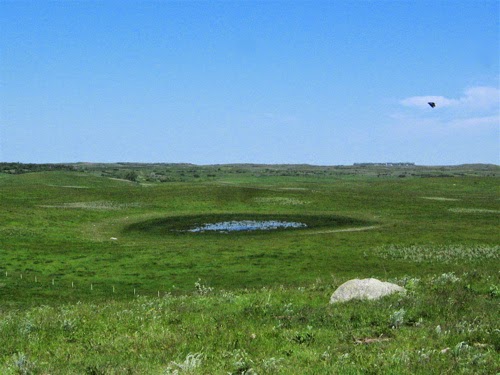Grassland in the prairie pothole region
American Prospect:
While few seem to be aware of it, a massive shift is under way in the northern plains, with ramifications for the quality of our water and food, and, more fundamentally, the long-term viability of our farms. A study published in February 2013 in the Proceedings of the National Academy of Sciences found that between 2006 and 2011, farmers in the Dakotas, Minnesota, Nebraska, and Iowa—the Western Corn Belt—had plowed up 1.3 million acres of native grassland in order to plant corn and soybeans. “People had been talking about the land conversion,” says Chris Wright, an assistant research professor at South Dakota State University and a co-author of the report, “but there weren’t any recent numbers.”I wouldn't believe a single word from the RFA, and the Corn Growers Association has little more credibility. While ethanol might not be all to blame for the higher commodity prices and the loss of CRP ground, it plays a very large part. China also contributes, but as you can see from livestock and meat prices, biofuels production has played a large part in livestock inventories becoming smaller.
Relying on satellite data from the U.S. Department of Agriculture (USDA), Wright and his co-author, Michael Wimberly, found that the rates of land-use change in the region—up to 5.4 percent annually—parallel the deforestations taking place in Brazil, Malaysia, and Indonesia. The shift represents the most rapid loss of grasslands since tractors began breaking sod on the Great Plains in the 1920s. Most of the conversion is happening on lands that are at risk from erosion or drought, and, in some cases, both....
To a large extent, the U.S. government has been telling its farmers what to do since the 1930s, when a combination of severe drought and careless agricultural practices led to widespread soil erosion, dust storms that darkened skies as far away as New York City, and the devastation of the nation’s heartland. Franklin D. Roosevelt introduced a shelterbelt initiative on the plains that involved the planting of hundreds of millions of trees, and 1956 saw the implementation of the Soil Bank Program, under which farmers signed multiyear contracts obliging them to adopt measures aimed at improving soil and water quality. When, in the 1980s, the policy of planting commodity crops “from fencerow to fencerow,” as had been advocated by longtime Agriculture Secretary Earl Butz, began to undermine those environmental gains, a Conservation Reserve Program, or CRP, was added to the 1985 farm bill. The initiative, which pays farmers to retire marginal croplands from production for 10 to 15 years, has been credited with helping to reduce erosion and damage caused by flooding and to increase wildlife habitat.
These days, though, in a trend that epitomizes the ongoing push-pull dynamic between the government’s desire for land stewardship and farmers’ inclination to increase their profits, CRP acreage is becoming harder and harder to find. Since 2008, some five million acres have been taken out of the program—more than all of Yellowstone, Everglades, and Yosemite national parks. In the Prairie Pothole Region alone, some 30 percent of CRP lands have expired in the past five years.
High commodity prices are an obvious catalyst for the shift. Between 2007 and 2012, corn and soy prices nearly doubled. At the same time, farmers have become more efficient at optimizing yields from the land. Lindstrom and others pointed to advances in technology—to giant, $400,000 combines equipped with precision GPS but ill-qualified to maneuver around pesky rocks and prairie potholes—and to genetically modified crops, which, by requiring less labor, enable farmers to plant more ground.
More than anything, though, federal policies are to blame for the changing face of the Western Corn Belt. In 2007, the government expanded the Renewable Fuel Standard, requiring oil companies to blend ethanol—made by fermenting and distilling corn—into the gasoline supply. The mandate started at 9 billion gallons and has risen each year since; it is now close to 14 billion gallons. The landscape alterations documented by Wright and the Environmental Working Group closely track the timing of the program’s introduction, although not everyone agrees the two are related. Commodity and ethanol groups like the South Dakota Corn Growers Association and the Renewable Fuels Association, for instance, dispute the connection.
It is interesting how short-sighted land use in the Dakotas is. 15 years ago, hunting the CRP ground was the main topic of conversation, as pheasant hunting and duck hunting drew in tourists from all around the country. Now that is almost gone, and if crop prices fall, which they will, folks will be pining for the grasslands plowed under. Thanks, ethanol mandate. As has been highlighted at Big Picture Agriculture, the prairie pothole region is very sensitive to erosion, and crop insurance makes a profit guaranteed when farming old grasslands. Nothing good will come of that.

You're telling me that there still is CRP ground? Not around here there isn't. It was all bought back when the corn price skyrocketed a couple years ago. I haven't seen a pheasant or quail in like forever, the deer population has plummeted and the number of songbirds at my feeders isn't anywhere near where it was before the Great Land Rush. In my admittedly biased opinion, a contract once signed is a contract. The buyout provision thing is quite simply corporate welfare.
ReplyDeleteSorry to be a comment hog.
Comment away. It's good to know somebody reads the stuff I put up here, and it's always good to hear what is happening in places other than the small part of Ohio I usually see.
ReplyDelete